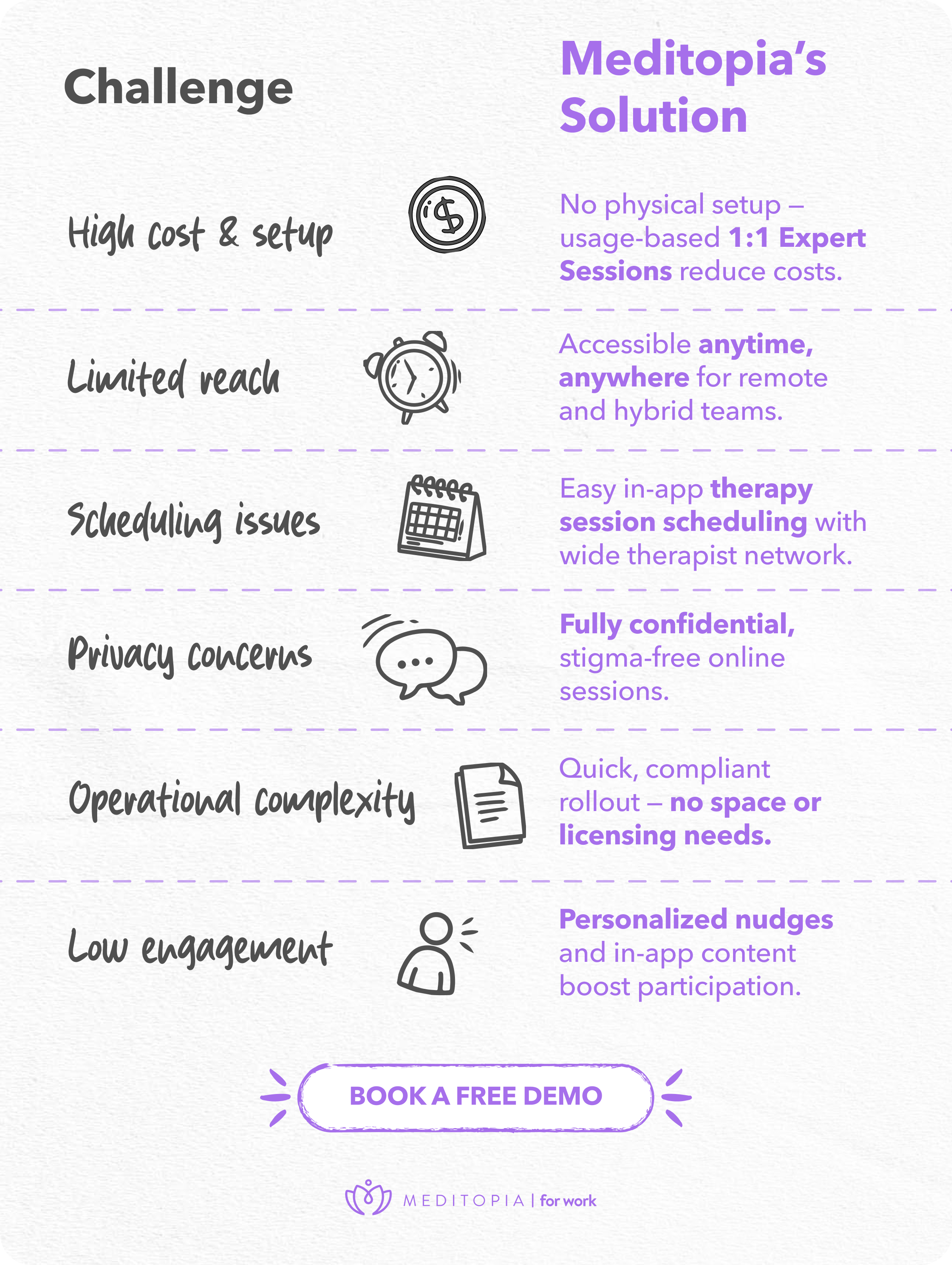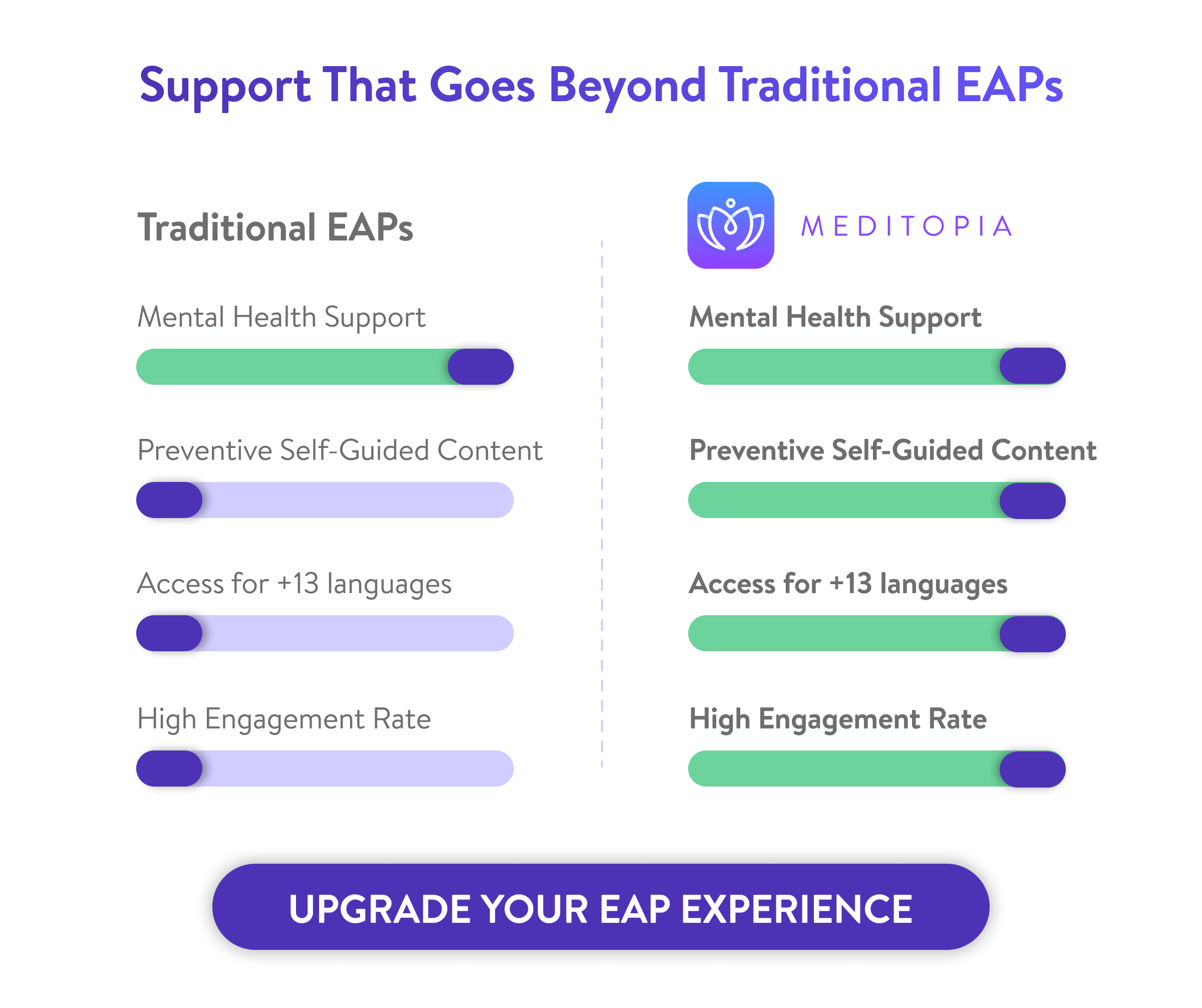The WHO estimates every $1 invested in mental health counseling returns $4 in improved health and ability to work, a figure that has underpinned modern wellbeing programs globally [1]. Let's explore how onsite therapy for employees can reduce abseenteism, increase productivity, and employee loyalty in your organization.
What Is On-Site Therapy?
Therapy, at its core, is a structured process that helps individuals restore balance—physically, mentally, or emotionally—through expert guidance and evidence-based interventions. In the workplace, it’s not just about treating illness but preventing it: identifying risks early, supporting recovery, and fostering a culture of proactive wellbeing. Programs often combine:
- Physical therapy (musculoskeletal assessment, early rehab, ergonomic coaching) frequently delivered as on site physical therapy or on site solutions physical therapy within occupational health services.
- Evidence from workplace studies shows that early, workplace-integrated physiotherapy reduces injury burden and improves outcomes [2].
- This is particularly valuable in industries like construction and security.
- Onsite occupational therapy (task analysis, functional capacity, ergonomic redesign) to accelerate return-to-work support after injury or illness.
- On site counseling / workplace counselling (psychologists, therapists, coaches) for stress, anxiety, grief, and performance issues. usually delivered privately on premises or via a dedicated onsite room.
- The macro-business case comes from WHO and Deloitte analyses linking support to fewer lost workdays and improved productivity.
How it’s delivered: Employers typically contract providers (as stand-alone clinics, in-house staff, or through an employee assistance program) to run scheduled clinics at HQ/plant sites. Programs may include drop-in hours, pre-booked therapy session scheduling, and referrals to external specialists when therapist availability is limited.
Top Benefits of On-Site Therapy Solutions
Talking about your work with friends is cathartical, but discussing your work challenges and receiving guidance from professionals opens the door to: improved mindset, a more resilient attitude, and higher self-confidence at work. Let's discover more benefits of onsite occupational therapy:
- Faster recovery & fewer days lost: Early, workplace-based physical therapy shortens recovery timelines and can reduce high-cost claims (particularly for back/shoulder injuries) by avoiding late, more expensive interventions.
- Expect lower absenteeism reduction and smoother return-to-work support as well [3].
- Improved mental health & morale: When mental health counseling is easily accessible, help-seeking rises and symptoms fall—tele-CBT and digital CBT are clinically effective, and on-site access further reduces barriers.
- Higher employee productivity: Poor mental health and presenteeism erode output; employers carry billions in hidden costs each year. Effective support helps recover lost days and boosts employee productivity [4].
- Signals commitment to wellbeing: Visible corporate wellness initiatives and integrated wellbeing programs foster trust and retention, especially when combined with manager training and clear comms.
- Potential long-term cost-effectiveness: Blending on-site clinics with targeted digital services often increases utilization and outcome-per-euro/dollar spent versus standalone legacy EAP models with low usage. (Global EAP studies show average utilization of 5–10%, limiting ROI if access is inconvenient or stigmatized.)
Meditopia's EAP has an outstanding 45% engagement rate thanks to our gamification features and expert-made programs. Send us a message to receive a free demo, and try yourself our employee mental wellbeing solutions before committing to a service.
The Hidden Challenges of On-Site Therapy
- High setup & operational costs: Dedicated rooms, equipment, and recurring provider hours add up—particularly across multiple sites or shifts. Meditopia takes care of these setups and integrations for you at no extra cost.
- Limited reach: On-site services are tied to location and clinic hours, creating access gaps for field teams, night shifts (like the ones in the retail and manufacturing industry), and remote work inclusion.
- Logistical complexity: Space allocation, clinical governance, licensing, and therapy session scheduling coordination stretch HR/OH teams, especially when therapist availability is tight. That's why Meditopia's experts allow to book session the same day, at the chosen availability of all employees.
- Stigma & visibility: Some employees avoid being “seen” entering a counseling room, citing confidentiality and privacy concerns, factors known to suppress help-seeking. Our on-site and online therapy sessions are entirely confidential.

On-Site vs. Digital Therapy: At-a-Glance Comparison
Should support stay physical, go digital, or blend both? The following comparison outlines how on site physical therapy and mental health counseling stack up against digital alternatives in key areas:
A Scalable Alternative: Meditopia’s 1:1 Expert Sessions
We believe in a holistic mental health approach. This means, we provide proven solutions for your unique workforce needs, in the physical and mental health realm. Here are some reasons why Meditopia's 1-1 care is ideal:
- Certified clinicians, real outcomes. Book 1:1 video-based sessions with licensed therapists, psychologists, coaches, and nutrition/fitness experts. Proven efficacy for tele-CBT and digital interventions: -21% stress, +27% positive emotions in 8 weeks.
- Access anywhere, any shift. Employees across plants, offices, and home sites can book discreetly, solving the location/time limits of in-house therapy.
- Cost-effectiveness. Pay for what people use; avoid fixed on-site staffing where utilization is uneven. This model addresses a core EAP problem—low usage—by meeting employees where they are.
- Private by design. Strong confidentiality and privacy reduce stigma and increase engagement.
- Easy rollout. HR can launch in days with SSO, therapy session scheduling, triage, and reporting to track absenteeism reduction and employee productivity improvements over time.














.jpg)










